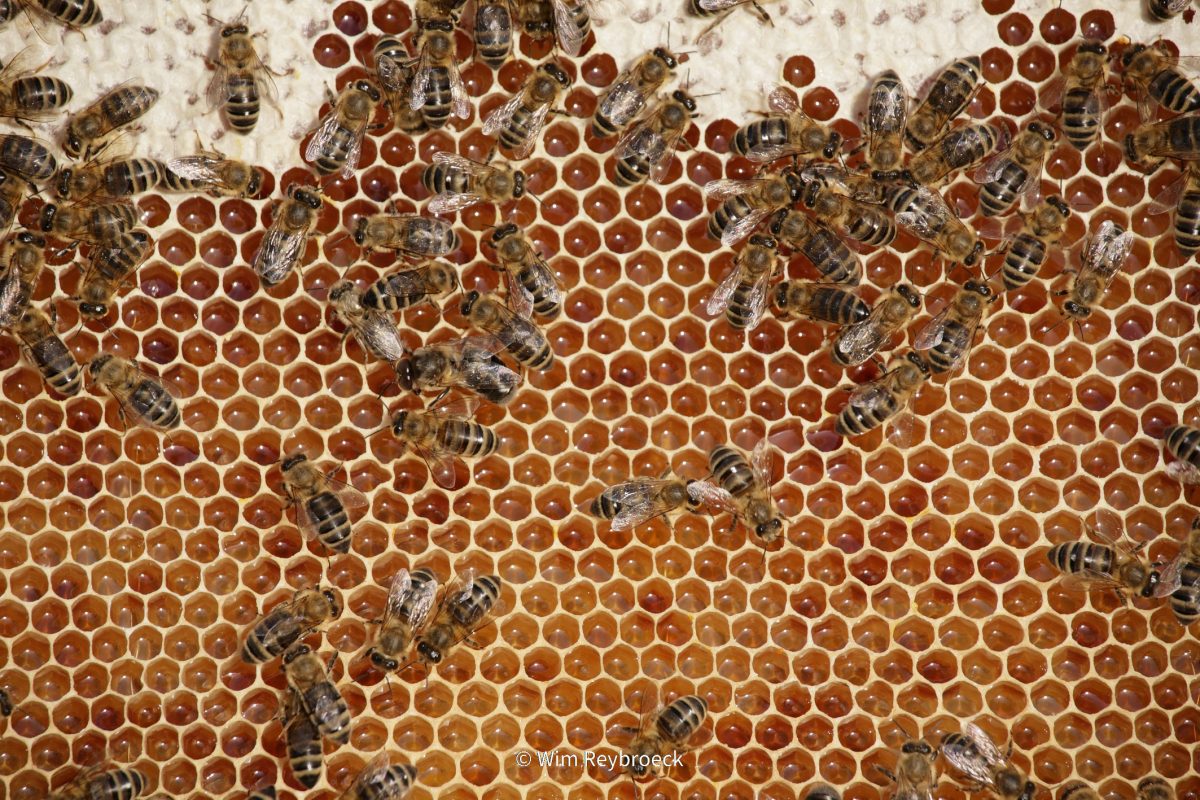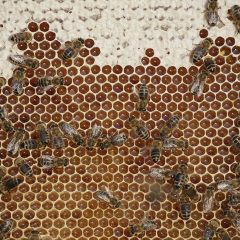Dossier Honey analyses
From January 1, 2023, the former Flemish Beekeeping Program (VBP) has been incorporated into the Common Agricultural Policy (CAP). From now on, this will be called Strategic Plan Beekeeping (SPB). From ILVO, a project proposal is submitted within SPB to offer Flemish beekeepers in 2023 again the possibility of free honey analyses and obtaining the "Guaranteed Quality" attestation and labels. Subject to approval of the project, beekeepers could bring in or send to ILVO a maximum of two honey samples, one spring honey sample and one summer honey sample. A trade-ready package and a digital analysis request will suffice (or a package accompanied by a signed analysis request). We would like to point out that it is also important that the honey sample is labeled with a correct honey label. All legal info should be clearly present on the label.

Honey samples are normally expected in the period June 15 - September 30, however, for 2023 projects have not yet been approved. Honey analysis can only be started after the project proposal is approved and signed. Since there is currently no visibility on the start date, we recommend waiting to send honey samples. However, you can register your interest via this form. You will then be contacted as soon as the honey analyses effectively start. Please note that funding is limited to 120 honey samples and once the provided budget is filled, no more samples can be analyzed.
Once analyses start, samples may be submitted. By submitting an analysis request (one sheet per sample), the beekeeper acknowledges the representativeness of the sample for the batch of honey with the same lot number. By signing in, the beekeeper authorizes ILVO to select and purchase its own sample from the same lot for further analysis. Randomly, this resampling can be done for representativeness control. Note that in case of detection of residues of antibiotics or sulfonamides above the set standards (action limits) or in case of the presence of a toxinogenic Clostridium strain, a notification obligation is in force in Belgium.
After analysis, the beekeeper receives a test report and in case of a favorable result, the beekeeper also receives an attestation and labels 'guaranteed quality'. For the latter, it is important to specify how many labels are desired. Obviously, these labels only serve to give the honey pots from the same lot an extra positive appearance. The beekeeper of a honey sample whose label does not comply with the current legislation will not receive an attestation (possibly the labels 'Guaranteed Quality'). If a honey complies with the legal standards with respect to the official quality parameters, but deficiencies with respect to presentation or the like are found, no attestation will be issued but the labels 'Guaranteed Quality' will be issued.
Practical agreements
Sign up via this form if interested in honey analysis. We will contact you as soon as the project is approved and the actual honey analyses start. From then on, honey samples can be brought in continuously at the reception of the Food Pilot, ILVO, Brusselsesteenweg 370, Melle Telephone 09/272 3000. The reception is continuously accessible on all working days from 8 am to 6:30 pm. There is a refrigerator in the reception where samples can be placed in case the secretariat is not staffed. Shipment is also possible, but it is very important to pack the sample very well to avoid breaking glass. Each sample should preferably contain half a kilo of honey. Please note that each glass goblet has a different weight, even if they are of the same brand and type. In connection with the assessment of presentation, it is requested to use a ready-to-use container (glass or plastic goblet). The sample should be representative of the rest of the honey designated with the same lot number. We would also like to point out the importance of the label. Each sample should be registered on the ILVO website or accompanied by a duly completed application form.
Analyses
This examination, in addition to an assessment of presentation, labeling, net weight, taste and crystallization structure, also includes chemical, physical and bacteriological analyses. Thereby, each honey sample is analyzed for intrinsic quality parameters such as moisture content, invertase activity (enzyme), hydroxy-methylfurfural content (HMF), electrical conductivity and specific rotation.
Additionally, random honey samples are subjected to residue screening for chloramphenicol, (dihydro)streptomycin, tetracyclines, macrolides & lincosamides, sulfonamides or fluoroquinolones.In addition, a limited number of samples will also be checked for authenticity.
This research will be extended from 2023 onwards with the determination of sugars (glucose, fructose, melezitose,...) in order to be able to give starting beekeepers an indication of the rate at which the honey will crystallize on the basis of the glucose/water ratio. The beekeeper's attention will also be drawn to the fact that the honey contains a lot of melezitose. Such honey is not suitable as winter food for the bees.
Given the increased interest in natural beekeeping and because of the detection in 2022 of toxinogenic Clostridium perfringens in Flemish honey, the honey research will be extended with bacteriological research on coliforms, sulfite-reducing anaerobic bacteria (Clostridium botulinum and Clostridium perfringens), osmophilic yeasts and xerophilic fungi. This research should allow a better understanding of the bacteriological quality and food safety of honey. Also, based on the number of yeasts and moisture content, advice can be given to beekeepers regarding the probability of fermentation and the shelf life of honey. This is especially relevant information for beginning beekeepers.
Labeling
We briefly sum up what must definitely be stated on the label in correct wording (see also the label for illustration).
- The sales designation 'HONING' or 'HONIG' or 'HONEY'
- The name and full address of the producer/importer
- The net weight
- The use-by date (maximum 2 years from harvest date)
- A lot number, if the date of minimum shelf life consists of day/month/year then this can also serve as the lot number.
- Country of origin where the honey was harvested. To participate in this honey analysis this must be 'Belgium' in this case.
- Storage conditions: 'Keep dry, dark and at a temperature below 15°C'. As honey with an increased moisture content is at risk of fermentation, it is considered that storage conditions should definitely be mentioned at a moisture content above 19%, or if it concerns honeydew honey already from 18% moisture. As mentioned in the Guide to Good Beekeeping Practice, such honey should be stored at a temperature below 11 °C.
Registration for honey analyses
Contact:
Wim Reybroeck - wim.reybroeck@ilvo.vlaanderen.be - +3292723011
Katrien Broekaert - katrien.broekaert@ilvo.vlaanderen.be - +3292722819
Contact an expert



